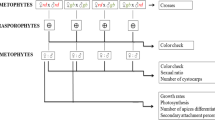Abstract
The first doubled haploid (DH) population of Porphyra haitanensis was created by crossing a wild-type line with a red type, artificial pigmentation, mutant line, by means of single somatic cell clone cultivation. Six quantitative traits (frond length (FL), frond width (FW), frond thickness (FT), fresh weight (W), growth rate of frond length (LGR), and growth rate of fresh weight (WGR)) from the DH population were analyzed. The frequency of each quantitative trait is in accordance with a normal distribution. Variable coefficients were between 20.43% and 57.35%, and while the mean of each quantitative trait was between the parents, it was closer to the paternal for six traits. Correlation analysis among the six traits showed significant positive correlations between FL and W, FW, and W, LGR and W, and WGR and W. There appears to be no correlation between FT and W. Heritability, number of genes controlling each quantitative trait and gene interactions, were also analyzed. Heritability of the six traits was greater than 70%, and heritability was not correlated with the number of genes controlling the corresponding quantitative trait. Frond thickness was the most heritable trait (95.30%), but this had the fewest control genes (7.52). According to the estimated coefficients of skewness and kurtosis, gene interaction was absent for LGR, but complementary gene interaction was observed in FW and W. In FL, FT, and WGR it is possible that complementary or duplicate gene interaction is involved. Our results enrich our understanding of Porphyra genetics and will help determine selection and breeding procedures for P. haitanensis.


Similar content being viewed by others
References
Asins MJ (2002) Present and future of quantitative trait locus analysis in plant breeding. Plant Breed 121:281–291
Caranta C, Palloix A (1996) Both common and specific genetic factors are involved in polygenic resistance of pepper to several potyviruses. Theor Appl Genet 92:15–20
Chen CS, Xu Y, Xie CT, Ji DH, Liu PJ, Liang Y, Wang FX, Shi XZ (2008) Preliminary study on mutation breeding of Porphyra haitanensis lines. J Fisheries China 32:327–34
Choo TM, Reinbergs E (1982) Analyses of skewness and kurtosis for detecting gene interaction in a doubled haploid. Crop Sci 22:231–235
Falconer DS (1989) Introduction to quantitative genetics. Longman Press, New York
Forster BP, Thomas WTB (2005) Doubled haploids in genetics and plant breeding. Plant Breed Rev 25:57–88
James BH (2007) Genetic architecture of complex traits in plants. Curr Opin Plant Biol 10:156–161
Liu FL, Shao ZR, Zhang HN, Liu JD, Wang XL, Duan DL (2010) QTL mapping for frond length and width in Laminaria japonica Aresch (Laminariales, Phaeophyta) using AFLP and SSR markers. Mar Biotechnol. doi:10.1007/s10126-009-9229-7
Miura A (1976) Genetic studies of cultivated Porphyra (Nori) improvement. Mar Sci 8:15–21
Peter MV, William GH, Naomi RW (2008) Heritability in the genomics era—concepts and misconceptions. Nat Rev Genet 9:255–266
Snape JW, Wright AJ, Simpson E (1984) Methods for estimating gene numbers for quantitative characters using doubled haploid lines. Theor Appl Genet 67:143–148
Sahoo D, Tang XR, Yarish C (2002) Porphyra—the economic seaweed as a new experimental system. Curr Sci 83:1313–1316
Wang QY (1981) A study of the heritability and genotypic correlation of some economic characters of Laminaria Japonica Aresch. J Shangdong Col Ocean 3:65–76
Wang SJ, Zhang XP, Xu ZD, Sun YL (1986) Studies on the cultivation of the vegetative cells and protoplasts of Porphyra haitanensis Chang et Zheng. Ocean Limnol Sinica 17:217–21
Wu CY, Lin GH (1987) Progress in the genetics and breeding of economic seaweeds in China. Hydrobiologia 151/152:57–61
Xie CT, Chen CS, Ji DH, Xu Y (2009) Characterization, development and exploitation of EST-derived microsatellites in Porphyra haitanensis Chang et Zheng (Bangiales, Rhodophyta). J Appl Phycol 21:367–374
Xie CT, Chen CS, Xu Y, Ji DH (2010) Construction of a genetic linkage map for Porphyra haitanensis (Bangiales, Rhodophyta) based on sequence-related amplified polymorphism and simple sequence repeat markers. J Phycol. doi:10.1111/j.1529-8817.2010.00855.x
Yan XH, Aruga Y (2000) Genetic analysis of artificial pigmentation mutants in Porphyra yezoensis Ueda (Bangiales, Rhodophyta). Phycol Res 48:177–187
Yan XH, Li L, Agura Y (2005) Genetic analysis of the position of meiosis in Porphyra haitanensis Chang et Zheng (Bangiales, Rhodophyta). J Appl Phycol 17:467–73
Yan XH, He LH, Huang J, Song WL, Ma P, Agura Y (2008) Cytological studies on Porphyra haitanensis Chang et Zheng (Bangiales, Rhodophyta). J Fisheries China 32:131–7
Yan XH, Lv F, Liu CJ, Zheng YF (2010) Selection and characterization of a high-temperature tolerant strain of Porphyra haitanensis Chang et Zheng (Bangiales, Rhodophyta). J Appl Phycol 22:511–516
Zeng GQ, Liu BQ, Yang R, Luo QJ, Wang YJ (2004) Morphogeny of conchocelis thalli from single somatic cell clone cultivation of Porphyra haitanensis. J Fishery Sciences China 11:549–53
Zhang GQ, He Y, Xu L, Tang GX, Zhou WJ (2006) Genetic analyses of agronomic and seed quality traits of doubled haploid population in Brassica napus through microspore culture. Euphytica 149:169–177
Zhang XC, Qin S, Ma JH, Xu P (2005) The genetic of marine algae. China Agriculture Press, Beijing, p 184
Acknowledgments
This research was supported in part by the National High Technology Research & Development Program of China (“863” Program; Grant No.2006AA10A413), the National Natural Science Foundation of China (Grant No. 40806065), the Construction Program of Science and Technological Platform of Fujian Province, China (Grant No. 2007 N2011).
Author information
Authors and Affiliations
Corresponding author
Rights and permissions
About this article
Cite this article
Xu, Y., Xie, C., Chen, C. et al. Genetic analyses of six quantitative traits of a doubled haploid population of Porphyra haitanensis Chang et Zheng (Bangiales, Rhodophyta). J Appl Phycol 24, 89–96 (2012). https://doi.org/10.1007/s10811-011-9653-8
Received:
Revised:
Accepted:
Published:
Issue Date:
DOI: https://doi.org/10.1007/s10811-011-9653-8




